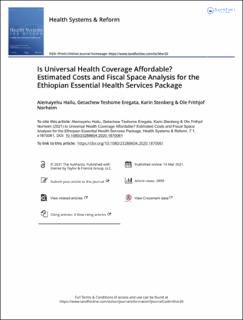| dc.contributor.author | Hailu, Alemayehu | |
| dc.contributor.author | Eregata, Getachew Teshome | |
| dc.contributor.author | Stenberg, Karen | |
| dc.contributor.author | Norheim, Ole Frithjof | |
| dc.date.accessioned | 2022-01-24T12:47:30Z | |
| dc.date.available | 2022-01-24T12:47:30Z | |
| dc.date.created | 2021-08-05T21:05:53Z | |
| dc.date.issued | 2021 | |
| dc.identifier.issn | 2328-8604 | |
| dc.identifier.uri | https://hdl.handle.net/11250/2838961 | |
| dc.description.abstract | Estimating the required resources for implementing an essential health services package (EHSP) is vital to examine its feasibility and affordability. This study aimed to estimate the financial resources required to implement the Ethiopian EHSP from 2020 to 2030. Furthermore, we explored potential alternatives to increase the fiscal space for health in Ethiopia. We used the OneHealth Tool (OHT) to estimate the costs of expanding the EHSP service provision in the public sector in Ethiopia. Combinations of ingredient-based bottom-up and program-based summary costing approaches were applied. We predicted the fiscal space using assumptions for economic growth, government resource allocations to health, external aid for health, the magnitude of out-of-pocket expenditure, and other private health expenditures as critical factors affecting available resources devoted to health. All costs were valued using 2020 US dollars (USD). To implement the EHSP, 13.0 billion USD (per capita: 94 USD) would be required in 2030. The largest (50–70%) share of estimated costs was for medicines, commodities, and supplies, followed by human resources costs (10–17%). However, the expected available resources based on a business-as-usual fiscal space estimate would be 63 USD per capita for the same year. Therefore, the gap as a percentage of the required resources would be 33% in 2030. The resources needed to implement the EHSP would increase steadily over the projection period due mainly to increases in service coverage targets over time. Allocating gains from economic growth to increase the total government health expenditure could partly address the gap. | en_US |
| dc.language.iso | eng | en_US |
| dc.publisher | Taylor & Francis | en_US |
| dc.rights | Navngivelse 4.0 Internasjonal | * |
| dc.rights.uri | http://creativecommons.org/licenses/by/4.0/deed.no | * |
| dc.title | Is universal health coverage affordable? Estimated costs and fiscal space analysis for the Ethiopian Essential Health Services Package | en_US |
| dc.type | Journal article | en_US |
| dc.type | Peer reviewed | en_US |
| dc.description.version | publishedVersion | en_US |
| dc.rights.holder | Copyright 2021 The Author(s) | en_US |
| dc.source.articlenumber | e1870061 | en_US |
| cristin.ispublished | true | |
| cristin.fulltext | original | |
| cristin.qualitycode | 1 | |
| dc.identifier.doi | 10.1080/23288604.2020.1870061 | |
| dc.identifier.cristin | 1924253 | |
| dc.source.journal | Health Systems & Reform | en_US |
| dc.identifier.citation | Health Systems & Reform. 2021, 7 (1), e1870061 | en_US |
| dc.source.volume | 7 | en_US |
| dc.source.issue | 1 | en_US |

